Dealing with blisters and foot pain during long-distance hikes necessitates an informed approach to preventative care. Blisters arise from shear forces and friction, often exacerbated by moisture and heat. Choosing well-fitted footwear and moisture-wicking socks is critical to minimize friction and pressure. Regular inspection for hotspots and the application of protective materials can avert blister formation. Incremental mileage increases and diversified training reinforce foot resilience. Post-hike care and moisture management further aid recovery and comfort. Proactive strategies, including sterile blister treatment and strategic foot preparation, guarantee an improved hiking experience. Further exploration will address these methods thoroughly.
Key Takeaways
- Choose properly fitted hiking boots and moisture-wicking socks to prevent blisters and foot pain.
- Regularly inspect feet for hotspots and apply protective tape to prevent blisters.
- Gradually increase hiking mileage by no more than 20% weekly to avoid overuse injuries.
- Manage moisture with foot powders and frequent sock changes to maintain dryness.
- Perform post-hike foot care, including massages and Epsom salt soaks, for relief and recovery.
Understanding Blister Causes
Blister formation during long-distance hikes is primarily attributed to shear deformation, a biomechanical process where bones within the foot move, causing repetitive friction that leads to tearing of the skin beneath the surface.
This phenomenon is exacerbated by shear forces and skin friction, particularly prevalent during the initial days of hiking. Monitoring foot conditions closely during these periods is essential to prevent blister development. The repetitive motion of hiking increases the likelihood of shear forces acting upon the skin, leading to fluid accumulation and blister formation.
Individuals should particularly focus on areas where blisters have previously developed, as these locations are predisposed to recurrent issues due to past tissue damage. Preventative measures should include minimizing skin friction through the use of protective barriers such as specialized blister plasters or lubricants.
Furthermore, controlling moisture and heat is imperative, as these elements can amplify shear forces, further aggravating skin friction and enhancing blister risk.
Contrary to common belief, calloused skin does not offer protection against blisters; rather, it may obscure the sensory feedback necessary to recognize early friction signs.
Regular inspection and timely intervention are essential in mitigating shear-induced skin damage during prolonged hikes.
Choosing the Right Footwear
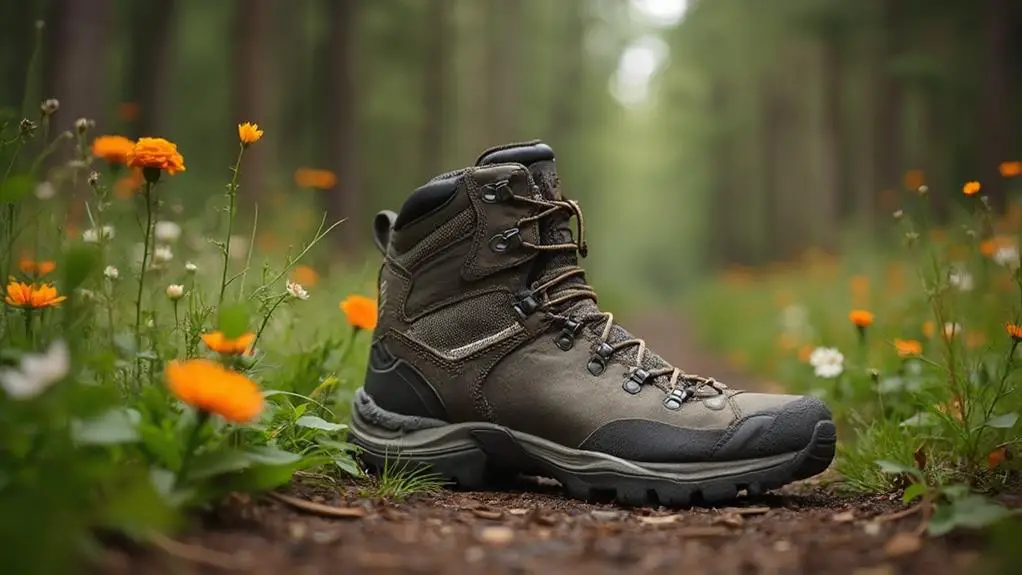
Selecting footwear that fits properly is paramount in minimizing friction and preventing blisters during prolonged hikes.
High-quality materials, including waterproof yet breathable fabrics, are essential to maintaining ideal foot hygiene and comfort.
Additionally, trying footwear later in the day and gradually breaking them in are critical strategies to guarantee a fit that accommodates natural foot swelling and reduces blister formation.
Prioritize Proper Fit
Guaranteeing a proper fit in hiking footwear is a critical preventative measure against foot pain and blisters during long-distance treks. The anatomical alignment and distribution of pressure are considerably influenced by foot shape and boot sizing. A shoe that securely holds the heel with minimal movement while offering ample space in the toe box is essential for reducing friction and subsequent blister formation.
It is recommended to size up by at least a half size, particularly when evaluating fit later in the day, to accommodate physiological variations such as foot swelling.
Different brands of hiking footwear cater to various foot shapes; consequently, trying multiple brands is advisable to identify the best fit for one’s specific foot type. This tailored approach helps distribute pressure evenly, mitigating the risk of dermatological conditions like blisters.
Additionally, selecting a high-quality hiking boot guarantees increased durability and protection, substantiating the investment for long-distance hikers.
Utilizing the intended hiking socks during the fitting process further refines the fit, facilitating an accurate evaluation of the boot’s interaction with the foot. This practice reduces friction, a primary etiological factor in blister development, thereby enhancing overall foot health during extended hiking endeavors.
Evaluate Boot Material
The intricacies of boot material selection play a significant role in blister prevention during long-distance hikes. Understanding the properties of synthetic materials versus leather boots is essential for ideal foot health.
Synthetic materials, characterized by their lightweight and breathable nature, offer superior moisture management. This quality is vital in mitigating the accumulation of sweat, thereby reducing the potential for skin maceration—a primary factor in blister formation. In contrast, leather boots, while durable, tend to retain heat and moisture, exacerbating conditions conducive to blister development.
Waterproof boots, although advantageous in wet environments, must also incorporate breathable technologies to prevent internal moisture buildup. A boot upper constructed with materials such as mesh not only facilitates ventilation but also provides structural support, thereby diminishing excessive friction and movement. This design is instrumental in minimizing epidermal shear forces that precipitate blister formation.
Furthermore, the inclusion of a cushioning midsole in boot construction serves a dual purpose: impact absorption and pressure distribution. These features are essential in mitigating plantar stress, thereby decreasing the incidence of blisters.
Selecting Ideal Hiking Socks
Selecting the appropriate hiking socks is essential in preventing foot blisters and reducing discomfort during long-distance treks.
High-quality socks made from moisture-wicking fabrics, such as merino wool, effectively manage perspiration, thereby minimizing friction and the risk of blister formation.
Additionally, socks featuring strategic cushioning and a proper fit can enhance comfort by alleviating pressure on high-impact areas, thereby contributing to overall foot health.
Moisture-Wicking Fabric Benefits
Moisture-wicking fabrics, such as those found in merino wool or synthetic blends, are essential in preventing foot complications during long-distance hikes. Advanced sock technology and fabric innovation have culminated in materials that effectively draw moisture away from the skin, thereby maintaining foot dryness and reducing blister risk.
These fabrics provide enhanced breathability, vital for thermoregulation and minimizing sweat accumulation, two key contributors to blister formation.
The clinical benefits of moisture-wicking socks are evident in their capacity to decrease foot irritation and improve comfort over extended durations. By facilitating moisture management, these socks play a preventative role in blister avoidance, a common affliction for hikers.
Consider the following:
- Reduced Friction: High-quality moisture-wicking socks often incorporate targeted cushioning, decreasing friction in high-wear areas, thereby lowering blister incidence.
- Temperature Regulation: Effective thermal management reduces excessive sweating and subsequent skin breakdown, a precursor to blister development.
- Enhanced Comfort: Shifting into dry, moisture-wicking socks during hikes can greatly maintain skin integrity, promoting overall foot health.
Incorporating moisture-wicking socks into hiking regimens aligns with evidence-based practices focused on injury prevention and ideal foot care, ensuring hikers can endure long trails with minimal discomfort.
Cushioning for Comfort
When starting on long-distance hikes, it is essential to prioritize foot health by selecting socks that offer ideal cushioning and support. Proper sock selection can mitigate the risk of hot spots and blisters, common nuisances in prolonged hiking activities.
Ideal sock thickness is vital, as it should balance between providing adequate cushioning without compromising the fit within hiking boots. Various cushioning types, such as extra padding in high-wear zones, can absorb impacts and reduce friction, consequently preventing blisters.
Evidence suggests that socks constructed from moisture-wicking materials like merino wool are beneficial for maintaining dry feet, as they effectively wick moisture away from the skin. This is important for reducing the incidence of skin maceration and subsequent blister formation.
A dual-layer sock system is another recommended strategy, wherein a thin liner sock minimizes skin friction while a thicker outer sock enhances cushioning, further preventing foot discomfort.
In addition to material selection, the presence of hidden seams or flat seams in socks is vital for minimizing chafing and irritation.
Regularly changing socks during hikes is advised to maintain ideal foot dryness and comfort, thereby decreasing the likelihood of blister development and foot pain.
Choosing Proper Fit
To prevent foot injuries such as blisters during long-distance hikes, it is vital to select hiking socks that fit properly. Proper sock thickness and sock materials are fundamental in minimizing the risk of dermatological injuries. Moisture-wicking materials, such as merino wool, are advocated due to their superior ability to maintain dryness by efficiently managing perspiration.
A snug fit, devoid of bunching, is essential to minimize friction and subsequent blister formation. Additionally, socks should incorporate extra cushioning in high-wear areas, including the heel and ball of the foot, to mitigate impact stress during extensive hikes.
For improved protection, consider employing a two-sock system: a thin liner sock made from polypropylene, worn beneath an outer wool sock. This dual-layer approach not only reduces friction but also optimizes moisture management. Regularly changing socks during hikes is vital to maintaining foot dryness and comfort, as moisture accumulation greatly increases blister risk.
Failure to prioritize sock selection can lead to debilitating consequences. Consider the following:
- Painful blisters can turn a joyful hike into an excruciating ordeal.
- Inadequate moisture management may lead to fungal infections.
- Persistent friction can cause long-term dermatological damage.
Prioritize sock selection to guarantee a comfortable and injury-free hiking experience.
Preparing Your Feet
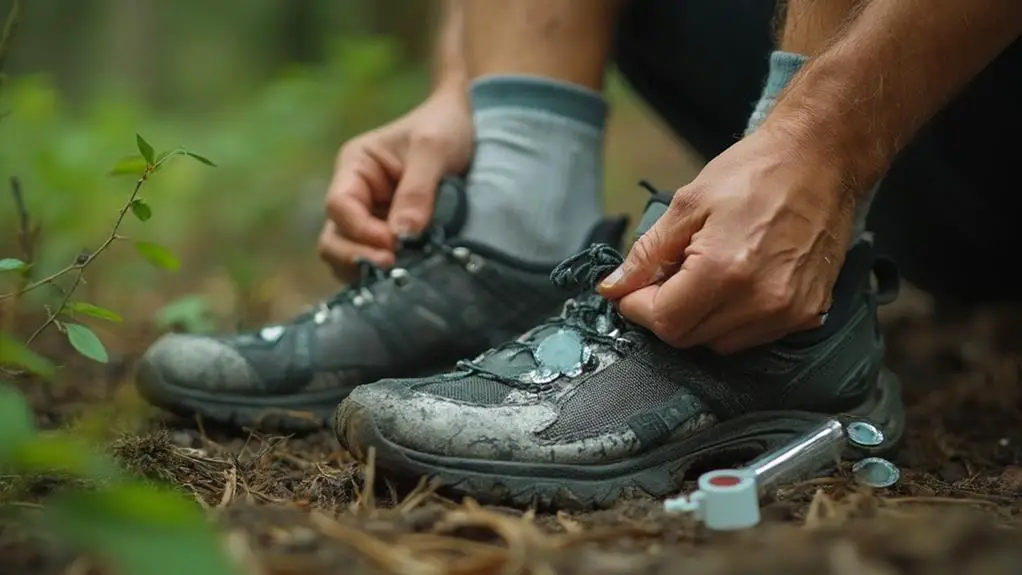
Proper preparation of the feet is essential to mitigate the risk of blisters and foot pain during long-distance hikes. Implementing rigorous foot hygiene is vital—keeping feet clean and dry minimizes friction, a primary cause of blister formation. Regular toenail trimming is advised to prevent discomfort and pressure points that may contribute to blister development.
Pre hike stretching should not be overlooked, as it enhances flexibility and circulation, preparing the feet for sustained physical activity.
To further safeguard against blisters, utilize specialized blister prevention products like tape or gel pads on known hotspots. These products act as a protective barrier, reducing shear forces and protecting sensitive skin areas.
Additionally, a progressive training regimen should be adopted, gradually increasing walking distances to acclimate the feet to prolonged exertion. This method strengthens foot resilience, decreasing susceptibility to pain and blisters.
Daily foot inspections during hikes are imperative. Identifying signs of irritation or hotspots early allows for timely interventions, such as repositioning protective products or adjusting footwear, to avert blister formation.
Such proactive measures guarantee that the feet remain in ideal condition, greatly enhancing hiking endurance and comfort.
Effective Moisture Management
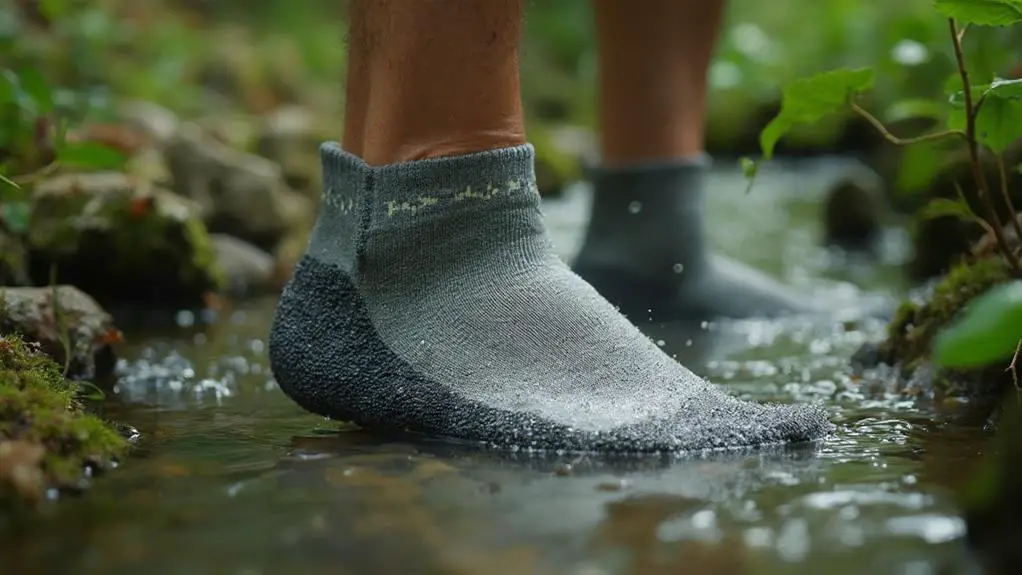
Moisture management plays a critical role in preventing blisters and maintaining foot health during long-distance hikes. Effective control of foot moisture is paramount for hikers, as it involves strategic use of sock materials and adherence to rigorous foot hygiene practices.
Utilizing moisture-wicking socks, crafted from Merino wool or synthetic fibers, is vital in keeping feet dry and mitigating blister risk. These specialized sock materials function by drawing perspiration away from the skin, reducing the potential for friction and skin maceration.
To enhance moisture control, hikers should consider the following practices:
- Utilize Foot Powders: Implementing products like Gold Bond Powder can absorb excess moisture, providing a protective barrier against blister development.
- Regular Sock Changes: Altering socks 1-2 times during extended hikes ensures sustained dryness and comfort, considerably lowering the risk of blister formation.
- Consider Liner Socks: Employing a dual-layer system by wearing liner socks under regular hiking socks effectively wicks moisture from the skin and minimizes friction.
Furthermore, maintaining ideal foot hygiene by guaranteeing feet are clean and thoroughly dried before donning socks is critical.
Avoid cotton socks, which retain moisture, exacerbating the risk of skin irritation and blisters.
Gradual Mileage Increase
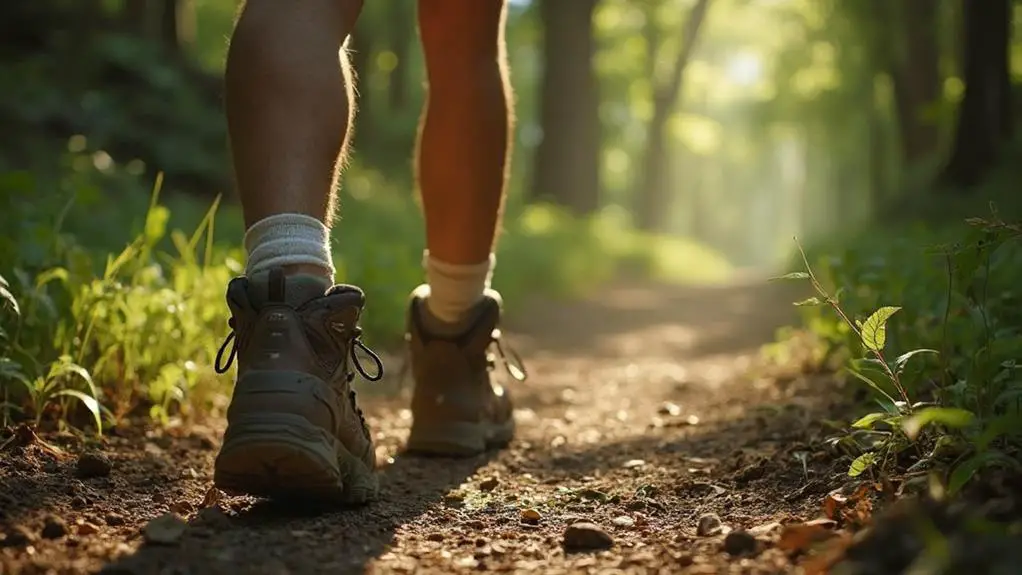
Implementing a gradual increase in hiking mileage, ideally no more than 20% weekly, is a fundamental strategy to prevent overuse injuries and facilitate adaptation to longer distances.
Regular monitoring for blister-prone areas during this progression is essential, allowing for early interventions to minimize blister formation.
Additionally, incorporating varied terrains and cross-training activities can enhance foot strength and resilience, ensuring a smoother shift to extended hikes.
Slow and Steady Progress
To mitigate the risk of blisters and foot pain during long-distance hikes, a gradual increase in hiking mileage is advised, with an increment limit of 20% per week. This strategy allows for physiological adaptation, thereby enhancing foot endurance and minimizing discomfort.
Incorporating structured training plans that include short, frequent hikes can bolster foot strength, while ensuring adequate hiking hydration and proper trail nutrition supports overall physical resilience.
Consider the following evidence-based recommendations:
- Gradual Adaptation: Incremental mileage increases enable the musculoskeletal system to adapt, reducing the incidence of overuse injuries and blister formation.
- Rest and Recovery: Adequate rest days are critical, allowing for tissue recovery and preventing the cumulative stress that leads to foot pain.
- Terrain Variation: Engaging in hikes over diverse terrains conditions the feet to handle variable challenges, further reducing the risk of discomfort.
Adherence to this gradual mileage increase protocol is paramount for maintaining foot health during extensive treks.
Combining this approach with ideal hydration and nutrition creates a robust foundation for enduring the physical demands of long-distance hiking.
Monitor Foot Health
Monitoring foot health is fundamental for preventing the onset of blisters and foot pain during long-distance hikes. A strategic approach to gradual mileage increase, not exceeding a 20% weekly increment, is recommended to facilitate physiological adaptation of the feet to extended distances. This controlled progression helps mitigate the risk factors associated with blister formation and foot discomfort.
Evidence indicates that most blisters develop by the second day of hiking due to cumulative friction and fatigue, underscoring the significance of vigilant foot inspections during early hike stages.
Proactive blister prevention involves identifying and managing blister-prone areas based on prior experiences. Recurrent blisters tend to manifest in similar locations, necessitating targeted preventive measures such as protective taping or specialized footwear.
Regular foot inspections are essential for early detection of irritation or hotspots, allowing for timely intervention to avert blister development. Additionally, integrating short walks and strategic breaks into the training regimen aids in conditioning the feet, while providing opportunities for cooling and ventilation during prolonged hikes.
The implementation of these evidence-based strategies is critical to preserve foot health and guarantee an ideal hiking experience, effectively reducing the incidence of blisters and associated foot ailments.
Adapt to Terrain Changes
Adapting to terrain changes demands a methodical approach, emphasizing the importance of a gradual mileage increase to prevent blisters and foot pain.
Progressive overload, a cornerstone of terrain adaptation techniques, suggests increasing hiking mileage by no more than 20% weekly. This incremental strategy allows physiological adaptation to new stresses, thereby minimizing injury risk. Incorporating diverse terrain types into preparatory hikes enhances foot conditioning, equipping them for specific challenges presented by elevation change strategies.
Preventative measures include meticulous monitoring of foot health, particularly during the initial days of a hike when blister formation is most prevalent. Many hikers underestimate the cumulative impact of elevation changes, often leading to undue wear and tear by day two.
To mitigate this, it is prudent to incorporate regular breaks, which facilitate thermoregulation and reduce moisture accumulation—key factors in blister prevention.
Consider the following:
- Vary Terrain Types: Expose feet to diverse surfaces to bolster resilience.
- Monitor Early Signs: Vigilance in the initial hiking days can prevent complications.
- Optimize Footwear Fit: Begin with shorter hikes to guarantee comfort and correct fit.
These evidence-based strategies are vital for hikers seeking to navigate long-distance trails with minimal discomfort and maximum endurance.
Identifying Blister-Prone Areas
A significant aspect of preventing blisters during long-distance hikes involves the early identification of blister-prone areas. Implementing effective blister prevention strategies requires an understanding of foot anatomy and the typical sites of friction-induced trauma.
Regular foot inspection techniques are paramount and should be conducted both pre-emptively and consistently throughout the hiking endeavor. This vigilance allows hikers to detect early signs of high-risk areas, particularly focusing on the heel, ball of the foot, and the sides of the toes—common sites where repetitive shear forces exert pressure.
Empirical evidence suggests that these regions are most susceptible to blister formation, especially on the second day of hiking, when accumulated stress and moisture exacerbate shear forces.
Consequently, proactive identification of these regions, coupled with personal history of previous blister occurrences, is essential for effective prevention. Hikers should pay meticulous attention to these areas, employing preventative measures such as adjusting footwear and using protective padding or lubricants as necessary.
Handling Hot Spots Early
Early recognition of hotspots is a vital step in the proactive management of blister prevention during long-distance hikes. Hotspots, characterized by localized pain or irritation, serve as early indicators of potential blister formation. Immediate intervention is essential to guarantee ideal comfort and foot health.
Regular inspection of feet during hikes facilitates early detection, enabling timely measures for hotspot prevention.
To effectively mitigate the risk of blister development, consider the following evidence-based strategies:
- Apply Protective Tape: Utilizing products like Leukotape can greatly reduce friction and provide a cushioning barrier. This method directly addresses the hotspot, minimizing pressure and irritation.
- Take Regular Breaks: Short, strategic pauses to air out feet and adjust footwear can alleviate pressure on identified hotspots. This approach not only aids in friction reduction but also promotes overall foot well-being.
- Consistent Monitoring: Vigilant and routine examination of the feet throughout the hike guarantees early identification of hotspots. This practice allows for immediate action, potentially preventing the progression to painful blisters.
Emphasizing these strategies enhances long-distance hiking experiences by prioritizing foot health.
Treating Blisters Safely
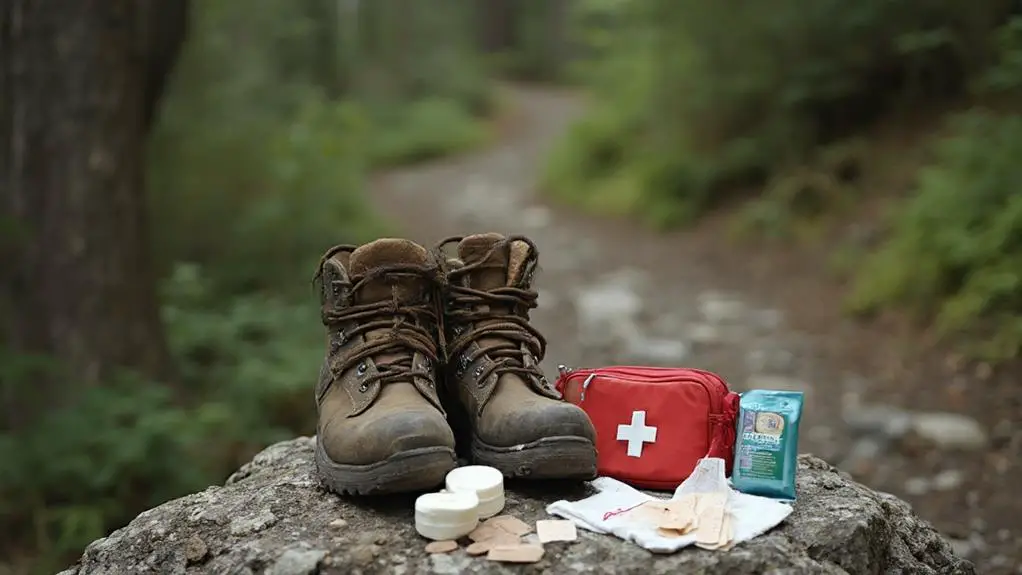
In the context of long-distance hiking, if blister drainage becomes necessary, it should be performed using sterile instruments to minimize the risk of infection.
It is vital to apply an antibiotic ointment post-drainage and cover the area with an appropriate dressing to shield the skin from further friction and contamination.
Vigilant monitoring for signs of infection, such as increased redness or swelling, is essential, and affected individuals should consider pausing activity if symptoms persist.
Safe Blister Popping
Blisters, though often seen as minor annoyances, can pose significant challenges during long-distance hikes if not managed properly. Proper blister care is essential for maintaining mobility and preventing complications.
In situations where popping a blister is deemed necessary, it is essential to employ a safe and sterile drainage technique. A sterile needle should be used to puncture the blister at its edge, allowing fluid to drain while preserving the overlying skin flap, which acts as a natural protective barrier.
Before initiating this procedure, stringent hygiene measures must be observed. Clean the area with alcohol wipes to reduce infection risk. Post-drainage, apply an antiseptic ointment such as Neosporin to further safeguard against microbial invasion.
Follow these steps diligently to mitigate potential complications:
- Infection Prevention: Failing to sanitize properly can lead to severe infections, jeopardizing your hike and health.
- Pain Management: Inadequate blister care may result in heightened discomfort, transforming a minor issue into an agonizing ordeal.
- Healing Optimization: Allowing the blister to breathe at night aids the natural healing process.
Sterile Treatment Tools
Equipped with the right sterile treatment tools, hikers can effectively manage blisters and prevent complications during their journey. Essential components of a hiker’s medical kit should include sterile needles for blister drainage, alcohol wipes, antibiotic ointment, and sterile bandages or blister pads. Ensuring these tools are stored in sterile storage is paramount to maintaining their effectiveness and preventing contamination.
Prior to any blister intervention, rigorous hygiene practices should be observed. Thoroughly cleansing the affected area with alcohol wipes considerably reduces the risk of bacterial introduction.
When it becomes necessary to lance a blister, the use of a sterilized needle is critical. It is advised to puncture the blister at the edge rather than the center, preserving the skin’s natural barrier to facilitate ideal healing.
Post-drainage care involves the application of an antibiotic ointment, such as Neosporin, followed by a sterile bandage. This dual approach not only protects the wound from further friction but also promotes an environment conducive to healing.
Vigilant monitoring of the blister for signs of infection—such as increased redness, swelling, or pain—ensures timely intervention if complications arise, safeguarding the hiker’s wellbeing throughout their trek.
Infection Prevention Measures
Effective infection prevention is vital when treating blisters during long-distance hikes, as it protects against complications that can impede a hiker’s progress.
Blister care begins with meticulous cleaning of the affected area using alcohol wipes to minimize infection risks and promote healing. If intervention is necessary, such as draining a blister, it is essential to employ a sterile needle to gently pierce the side, making sure the skin flap remains intact to shield underlying tissues from bacterial invasion.
After drainage, the application of an antibiotic ointment, such as Neosporin, is recommended to mitigate infection risks and should be followed by covering the blister with a protective pad or bandage. Vigilant monitoring for signs of infection, including increased redness, swelling, or purulent discharge, is important. Should these symptoms manifest, seeking prompt medical evaluation is advised.
To reinforce blister care, allow the area to breathe overnight by removing bandages, facilitating drying and reducing infection risks. This practice guarantees adequate ventilation and supports recovery.
Consider these steps to maintain foot health:
- Regularly inspect feet for blisters.
- Prioritize sterile procedures.
- Act swiftly at infection signs.
Such measures are indispensable for sustaining hiking endurance and health.
Essential Blister First Aid Kit
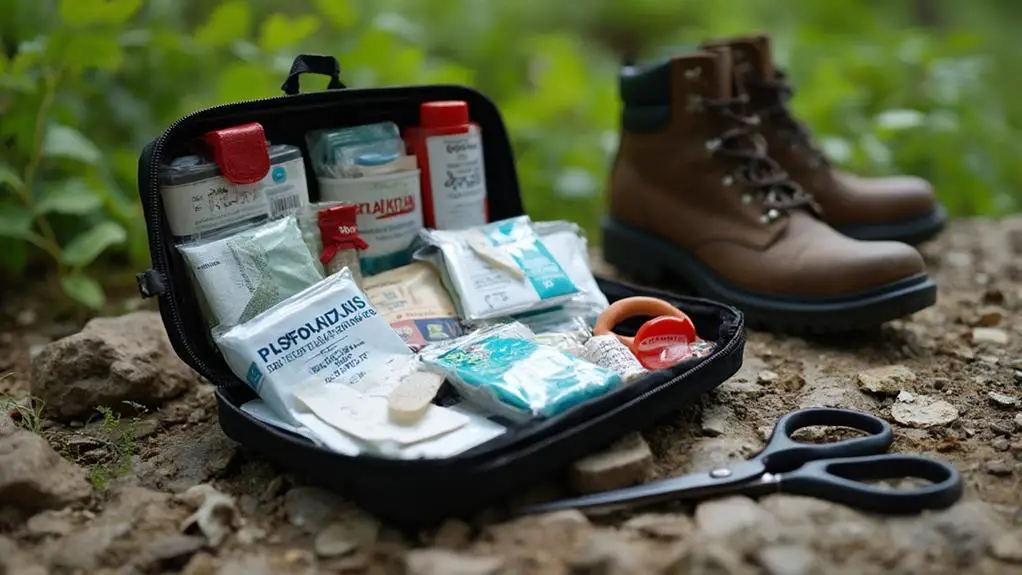
When starting on long-distance hikes, it is crucial to be prepared with an essential blister first aid kit to effectively manage and prevent foot injuries. Blister prevention is a critical component of maintaining foot health during extended treks.
An ideal kit should include alcohol wipes for cleaning the affected area, ensuring a sterile environment to minimize infection risk. Antiseptic ointment is recommended to further mitigate potential infections post-cleansing.
Sterile bandages and blister pads, such as Spenco 2nd Skin, are necessary for cushioning and shielding vulnerable areas. Engo Blister Patches and hydrocolloid dressings offer targeted protection on known blister-prone regions, enhancing healing processes through moisture retention.
For immediate intervention on developing hotspots, carry Leukotape or moleskin to avert blister formation.
A pair of scissors and a sterilized needle are necessary tools for precise trimming and, if required, safe drainage of blisters. Following drainage, application of an antibiotic ointment like Neosporin is advised to support healing and prevent bacterial contamination.
This structured approach, integrating first aid essentials with evidence-based blister prevention strategies, enhances foot care and improves hiking experiences.
Post-Hike Foot Care

After completing a long-distance hike, attention to post-hike foot care becomes vital for preventing further complications and guaranteeing swift recovery. Engaging in post hike rituals is essential to mitigate discomfort and promote foot health.
Begin by promptly removing any wet socks and boots to allow the skin to breathe, considerably reducing the risk of blisters and moisture-related issues. Implementing a routine foot massage using appropriate techniques can enhance circulation and alleviate tension in the muscles and tissues.
Here are three important steps to include in your post hike rituals:
- Inspect and Treat: Thoroughly examine your feet for any signs of irritation, blisters, or hotspots. Immediate treatment of these issues can prevent exacerbation and aid in recovery.
- Foot Powder Application: Utilize Gold Bond Powder or similar products to absorb excess moisture and maintain dryness, vital for preventing skin maceration and related complications.
- Foot Soak: Consider a soothing foot soak with Epsom salt to relieve soreness and foster relaxation, promoting the natural healing process of fatigued feet.
Maintaining well-groomed feet by regularly trimming toenails is also essential. Such preventative measures not only guarantee comfort but also minimize the risk of injury in subsequent hikes.
Utilizing Sock Liners
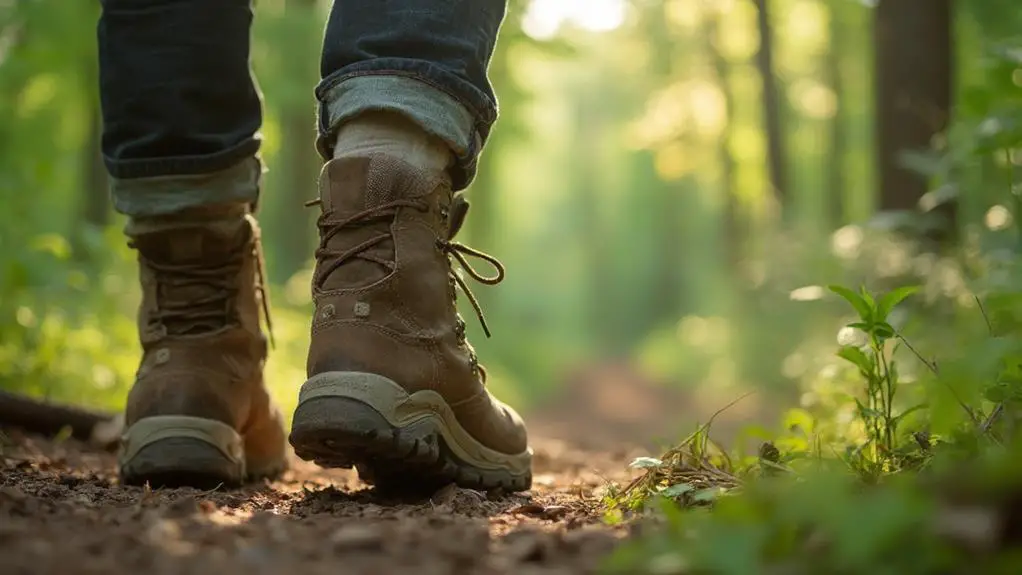
Post-hike foot care lays the groundwork for continued foot health, but proactive measures during the hike play an equally significant role in preventing blisters and foot pain.
Utilizing sock liners is an evidence-based strategy that enhances foot protection by minimizing friction and shear forces, vital factors in blister prevention. Sock liners, typically crafted from moisture-wicking materials such as polypropylene or merino wool, provide substantial sock liner benefits by effectively reducing moisture accumulation. This reduction in moisture is essential in minimizing skin maceration and subsequent blister formation.
Incorporating a dual layer system, where a snug-fitting sock liner is worn beneath a thicker outer sock, offers enhanced protection against skin shear forces. This system not only improves comfort but also decreases the occurrence of blisters, particularly in high-risk areas such as between the toes.
Injinji toe sock liners exemplify this concept, as they individually encapsulate each toe, thereby preventing chafing and blistering.
To maintain peak efficacy, it is recommended to replace sock liners during prolonged hikes to guarantee dryness and comfort. Properly fitted sock liners should be snug without causing constriction or additional friction points, further enhancing their preventative benefits.
Keeping Debris Out
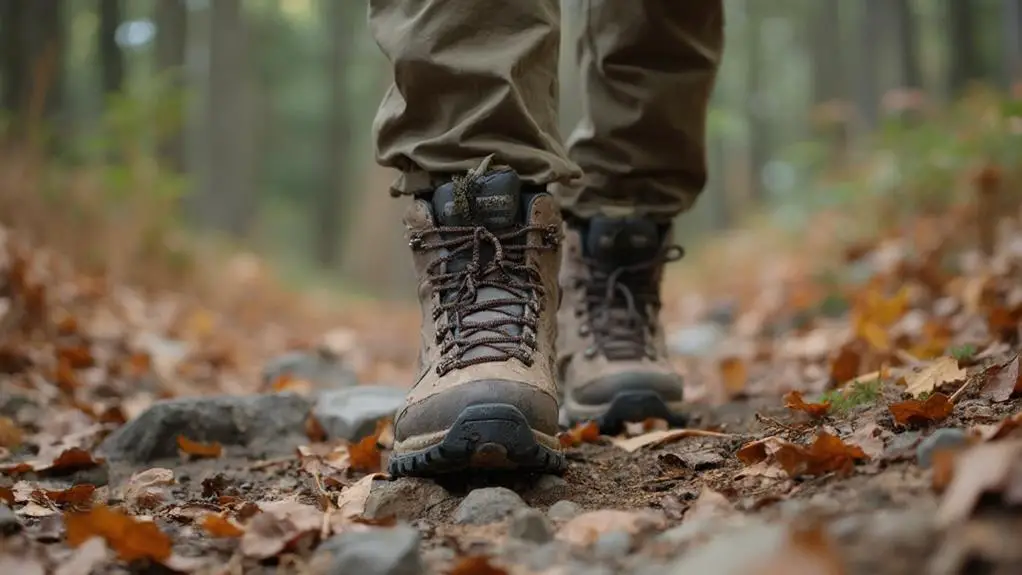
Keeping debris out of hiking boots is a essential preventative measure to maintain foot health and mitigate the risk of blisters during long-distance hikes. Debris prevention strategies are vital in ensuring a comfortable and injury-free hiking experience.
Utilizing low gaiters has proven effective in blocking dirt, rocks, and twigs, thereby reducing irritation and subsequent blister formation. Gaiter effectiveness is enhanced by their ability to create an additional barrier against environmental elements, safeguarding the feet.
To maximize protection, consider these necessary steps:
- Regularly shake out your boots: This simple yet effective practice helps remove trapped debris that can cause friction and irritation, greatly reducing the risk of blisters.
- Secure your boot lacing technique: A snug fit not only minimizes movement and friction but also helps to prevent debris from entering the boots, further protecting the feet from potential injury.
- Opt for waterproof, breathable hiking boots: These specialized boots prevent moisture buildup, offering an additional layer of protection against debris-induced blisters and foot pain.
Incorporating trail-specific footwear designed to minimize debris entry will enhance comfort and safeguard against irritation.
Engaging With Hiking Communities
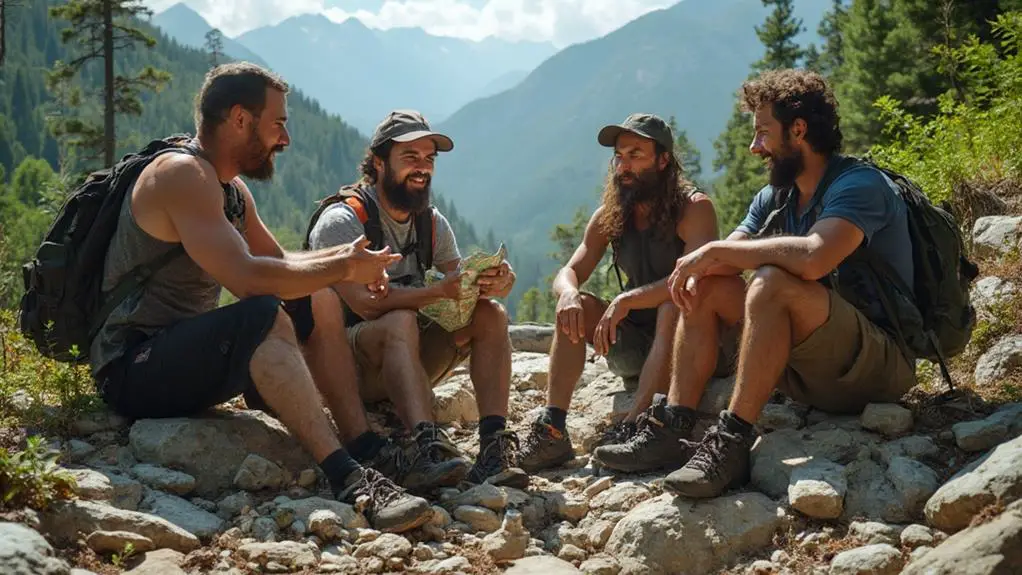
Engaging with hiking communities offers a multitude of benefits in advancing blister prevention and treatment strategies, providing hikers with access to a wealth of shared experiences and evidence-based recommendations.
Community support plays a critical role in disseminating practical knowledge about foot care practices, which are essential in preventing blisters during long-distance hikes. Many hiking communities utilize forums and social media platforms to exchange personal narratives, tips, and product suggestions. Such exchanges allow for the identification of effective prophylactic measures and therapeutic interventions grounded in real-world applications.
Local hiking clubs frequently facilitate shared experiences through the provision of blister management kits and the cultivation of a knowledgeable membership base. These clubs often host community events, including group hikes and workshops, which serve as forums for discussing recurrent issues such as blisters and foot pain.
These gatherings foster a sense of camaraderie and support among participants, promoting adherence to best practices in foot care.
Additionally, online resources like webinars and articles from seasoned hikers augment community knowledge by highlighting the significance of appropriate gear selection and advanced blister management techniques.
Exploring Additional Resources
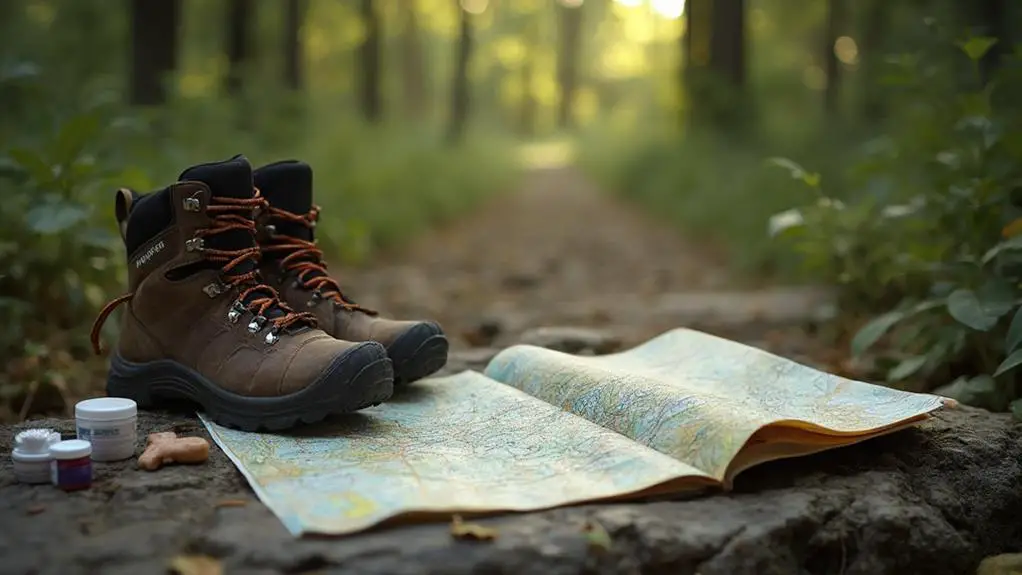
While engaging with hiking communities provides a valuable foundation for blister prevention, individual hikers can further enhance their knowledge through targeted resources. Embracing evidence-based strategies and preventative advice is vital in mitigating the risk of foot injuries during long-distance hikes.
For instance, the “Fix My Foot Blisters Fast” program offers an extensive suite of blister management strategies, granting lifetime access to hikers seeking in-depth understanding and practical solutions. In addition, participating in a free 45-minute webinar focused on blister prevention can furnish hikers with insights into causative factors, effective preventative measures, and on-trail treatment options.
Beyond structured programs, leveraging community resources and online forums can be instrumental in staying informed about innovative blister management techniques and products. Essential items such as Engo Blister Patches and hydrocolloid plasters should be considered indispensable components of a hiker’s toolkit.
Furthermore, hikers are encouraged to explore various online platforms, including hiking blogs and articles, to acquire current knowledge and community feedback. To underscore the importance of these resources, consider the following:
- Uncover new prevention techniques: Stay ahead with the latest blister prevention strategies.
- Gain insights from fellow hikers: Learn from shared experiences and advice.
- Access a wealth of knowledge: Utilize webinars, articles, and specialized programs.
Frequently Asked Questions
How Do Hikers Deal With Blisters?
Hikers prioritize blister prevention through the application of protective tapes, moisture-wicking socks, and dual-layer sock systems. Blister treatment methods include antiseptic ointments and sterile bandages, with careful blister drainage and antibiotic application advised when necessary to prevent infection.
How Do You Walk Long Distance With Blisters?
To walk long distances with blisters, employ evidence-based strategies such as blister prevention through proper hiking footwear, applying moleskin or blister pads, adjusting footwear fit, maintaining foot hygiene, and moderating hiking pace to minimize friction and discomfort.
How Do Long Distance Runners Deal With Blisters?
Long-distance runners mitigate blister formation by employing blister prevention measures, such as selecting appropriate running footwear and utilizing moisture-wicking socks. Evidence-based strategies include lubricants, dual-sock systems, and regular foot care to enhance circulation and reduce friction-induced injuries.
How to Stop Feet From Hurting When Hiking?
To prevent foot pain when hiking, guarantee proper footwear with adequate support and fit, utilize moisture-wicking socks, and prioritize thorough foot care. Gradually increase hiking distance and incorporate regular rest intervals for ideal preventative outcomes.
Conclusion
In addressing the challenges of blisters and foot pain during long-distance hikes, it is imperative to understand the underlying causes and implement preventative strategies. Selecting appropriate footwear and socks, alongside proper foot preparation and moisture management, can greatly mitigate the risk of injury. The use of sock liners and techniques to prevent debris intrusion further enhance foot health. Engaging with hiking communities and exploring additional resources provide valuable insights and evidence-based practices for maintaining ideal foot condition during extended hikes.